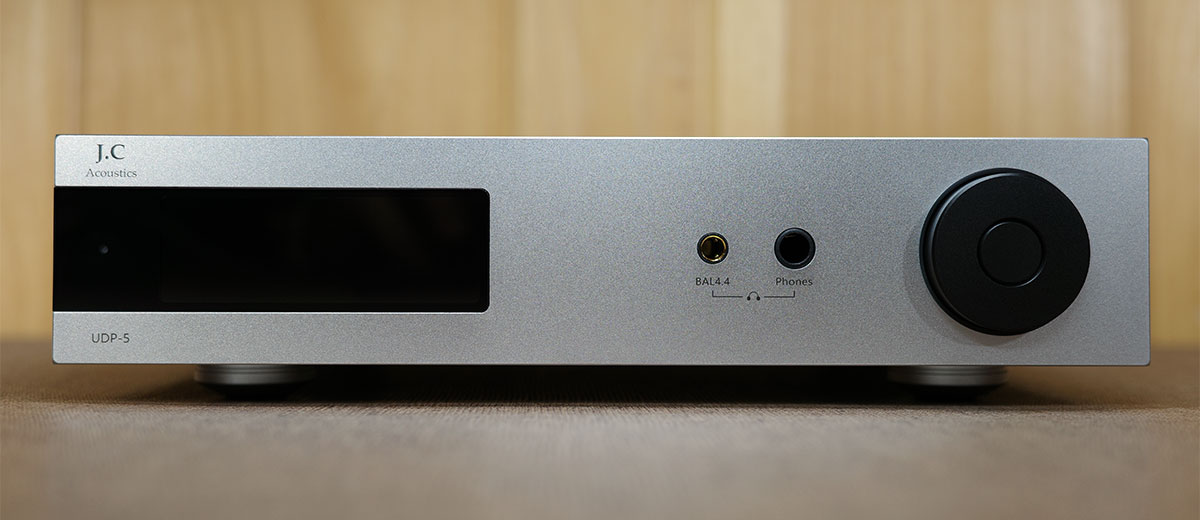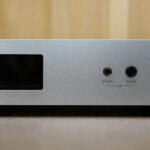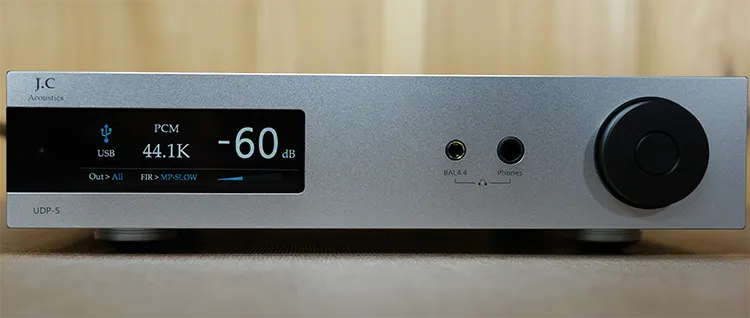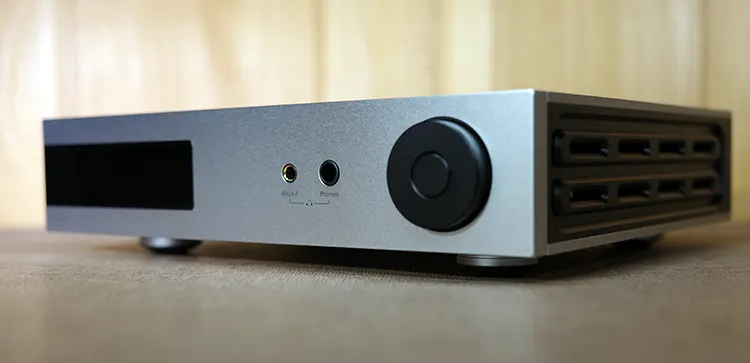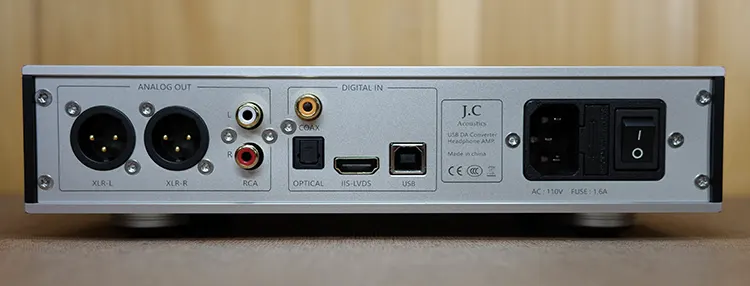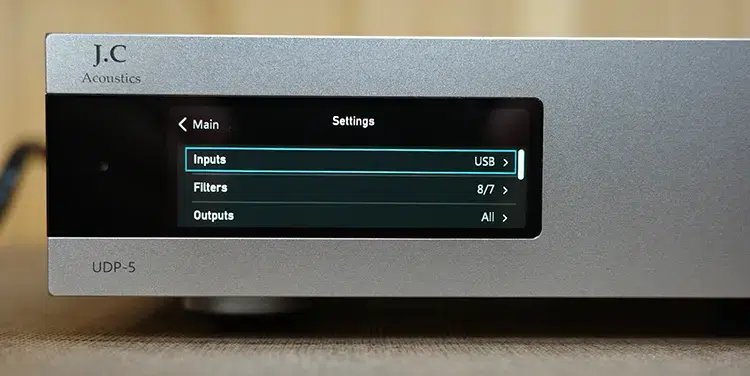Today, Lynn reviews the J.C. Acoustics UDP-5, which is a new desktop integrated ES9039Q2M DAC and 6.8W capable fully balanced headphone amplifier. It is priced at $749.99.
Disclaimer: This sample was sent to me for my honest opinion. Headfonics is an independent website with no affiliate links or status. I thank Shenzhen Audio for their support
To read more about Shenzhen Audio products previously tested on Headfonics click here.
Note, that this article follows our latest scoring guidelines which you can read here.
We have not had the pleasure of reviewing any J.C. Acoustics products in the past. With two models to their name, the UDP-5 Delta Sigma DAC/Headphone amplifier was sent to me for review.
Among the options you can get on either model are a remote, and passive side venting fans, which help reduce potential heat build-up from the 6.8W of power through the 4.4mm balanced connection.
Built to similar dimensions of previously reviewed desktop units such as the Audalytic AH90 and the YULONG DA-ART Aquila III, but smaller than the just reviewed FiiO K9 AKM, makes for some interesting comparisons. Power is quite good, and the trim looks make for a standout from the crowd.
Features
DAC
The J.C. Acoustics UDP-5 is a standalone midrange desktop DAC/Headphone amplifier and uses two near-flagship ESS ES9039Q2M chips for decoding. The chips are also isolated from interference by placing them away from the FPGA core processor and the balanced amplifier circuits.
Using a 16-core XMOS XU216 USB interface, the UDP-5’s USB-C decoding supports high-resolution audio streams of up to DOP & Native DSD64-DSD512 and PCM of 16-32bit, up to 32K-768KHz.
Amplification
The UDP-5’s balanced PO output produces an impressive 6.8W at 32Ωs. Raising the volume produced a liner response, instead of a sudden increase in sound like the beastly XDuoo TA-30 does. I appreciated that linearity.
The smooth performance can be attributed to FET OP1642 on the front end, with TPA6120A2 parallel balanced amplifier circuits closing the deal. Optimized are the start-up delay and headphone protection circuits of the audio line-out for further protection from spikes.
Output power does drop using the 6.35mm single-ended jack to “only” 90mW@600Ω, but I found my 600Ω AKG 240DF could be used, albeit at -13 dB, which was nearly full volume.
At 0 dB, the AKG was louder than I could sustain so the UDP-5 can definitely drive high-impedance headphones.
Design
The UDP-5 carries the typical slim-height dimensions of desktop amplifiers with dimensions of 239*50*208mm (deeper by over an inch from the AH-90) and a weight of 3kg. This falls right in line with its peers, but the design sets itself apart with many differences.
The large black volume knob dominates the front right, with two features described below. Matte black and plastic, it does not look out of place.
To the left are the two headphone jacks labeled in black lettering on the silver design. Moving to the screen on the left, the volume level carries the largest lettering part of the equally split 3” IPS screen.
The decoding level is to the left, and the input source is to the left of that, (with a matching icon of your chosen source).
Below the three items above is a smaller script describing what outputs are “live,” which means you can keep all active or isolate a single output option further diminishing potential interference from within. To the right of that is filter choice, then a volume ramp showing progress across the full volume scale.
I found the lettering and choices to be easily readable from my desktop setup, and easier than some alternative units that have larger lettering.
The sides carry black vents to dissipate heat from the large amplifier, and as an option, you can order a separate radiator fan unit for each side, which further cools the unit (they move passively).
Mine did not come with those, but I wish for that and the optional remote to try them out. I recommend both options.
Aviation aluminum is finished with ceramic sandblasting on par with our Smartphone technology, showing the precision taken in construction.
I/O
The rear carries in separate sections the analog choices of RCA and XLR; and digital of coax, optical, USB, and IIS-LVDS, along with the power plug separated from the on/off switch.
This last feature is greatly appreciated for it is on the outside, making for an easy reach compared to many on the market. You can long-press the “menu” knob on the front to put the UDP-5 to sleep, which means you can turn the back switch on and leave it.
The front looks sleek and efficient, with only the large volume knob on the right that doubles as a control unit.
The 3” ISP screen on the left is easy to read, even with the smaller lettering. While the menu changing is a bit of a letdown functionally, the choices from the sub-menus are not.
You can tailor everything from filter choice, keeping all the outputs running, turning off all but the current connection, changing volume, enabling the S/PDIF clock, configuring how the chip runs, and swapping channels to name but a few key features.
Controls
As per typical, a volume knob dominates the frontal look, on the right; but carries the multi-function button within. Volume is controlled by the larger outside knob, with the inner button functioning as the option to get into the menus.
Once into the menus, the volume wheel is used to move to your choice. Much like a Nikon (or Canon) camera uses the center knob for entering into the sub-menus, the UDP-5 does the same.
Post choice, you then scroll back to the top to “exit” that menu. I do wish for a separate “return” button or knob, though.
Packaging & Accessories
The UDP-5 comes well packaged, in a larger-sized box for protection. The box is mainly for protection, with two foam inserts that wrap around the UDP-5, after putting it into the protective plastic sleeve.
A box set above the unit carries the power cord and owner’s manual. No cables are included.
Sound Impressions
The J.C. Acoustics UDP-5 was given plenty of break-in time, letting it play for over 75 hours before the analysis was made.
I used the Empire Ears Legend X, (with a PLUSSOUND Copper XL balanced cable), for IEM use, and the Crosszone CZ-8A Enhanced, AKG 240DF, and ZMF Headphones Eikon (XLR) were used for gauging headphone use.
The OPPO BDP-83/Klipsch The Sixes were used for two-channel purposes, and the Shanling M6 Pro along with the Cayin N6ii for DAP listening purposes.
Summary
Coming off some very fine DAC/Amps the UDP-5 has some large shoes to compete with, especially at the listed price.
What I did not expect was for an ESS-chipped DAC to sound more like an AKM-chipped set than the former’s known clean, clarity-driven sound. The ESS-chipped UDP-5 comes across as musically smooth, without any of the potential pitfalls known such as piercing highs or thinner note quality.
I found the UDP-5 sounded organic without becoming too thick or slow across many listening platforms, including harder-to-drive headphones such as the ones I used.
Filter choice can fine-tune the sound a bit but should not be relied upon to make a huge difference. Think of those choices as additive instead of changing.
I did note some holographic effects to some of the choices such as Linear phase-fast-sharp roll-off; something I was not expecting. This became my favorite filter setting but will note different choices when appropriate.
Timbre
While not quite as smooth as a Burr Brown, the UDP-5 nonetheless comes across with a smooth, organic texture that belies its ESS heritage.
Even so, detail quality comes across as distinct, but not sharp. The vibrancy of notes is tethered a bit by the tune, but not to the detriment of the overall quality. Where the Aquila III is a sharp surgeon’s scalpel, the UDP-5 is a quality bread knife.
Evoking the smooth texture of notes helps to keep note weight thicker, but not slow. The lack of punctuating upper notes played well with my preferences and treble intolerance. Even when changing to a faster, more responsive filter choice, I was not left reaching to turn the volume level down.
Dynamics
The warmer signature does not hinder the dynamic range, especially when you use a more vibrant-sounding IEM or headphones. A brighter-sounding headphone will sound a bit tamed, but not enough to hinder the quality of that offering.
Piano and sax solos came across as velvety without becoming slow or molasses-like, evoking quality from the notes, which added to the quality offered listened to.
The accuracy of the notes dynamically speaking was very good. Spatial awareness was quite good, with an accuracy that fit more in tune with a typical ESS tune.
Imaging
Those notes were allowed to breathe within the sphere taking an accurate place across the soundstage and layering.
If the instrument was set forward in the recording, it came across accurately, while channel-dependent parts such as jazz sax solos came accurately from their side, with a slight delay and reverb, which the recording engineer intended.
Compared to the YULONG Aquila III, where the Aquila III was very, very good at placement; the UDP-5 did not give up much, adding an organic naturalness to the placing of notes. Smoothness versus pinpoint accuracy. The notes came across as warm, and rich with better weight than the recently tested FiiO K9 AKM.
This is not a slight against the FiiO mind you, but rather the J.C. Acoustics ran a bit weightier and more accurate. Different tunes achieve the same result of giving the listener a choice.
The 3D spatial aspect plays well across the imaging, with little effort needed to properly place the instruments in the left-right space, and height. Depth was as good as width making for an engaging cubic effect to the staging.
Click on page 2 below for my recommended pairings and selected comparisons.

